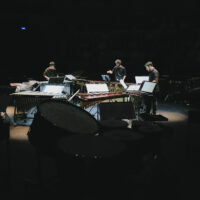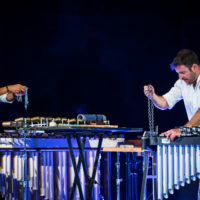Musicians: Minh-Tâm Nguyen, Thibaut Weber, Alexandre Esperet / Hsin-Hsuan Wu
Program :
Trio Sonata for organ – Johann-Sebastian BACH (1729-30)
Les Invariants – Michaël LEVINAS (2021)
Trio Sonata for organ – Johann-Sebastian BACH (1729-30)
Rain Tree – Tōru TAKEMITSU (1981)
Trio Sonata for organ – Johann-Sebastian BACH (1729-30)
Invariants is a programme for a trio of musicians playing percussion keyboards. Interspersed between three Trio Sonatas for Organ by Johann-Sebastian BACH, Rain Tree (1981) by Tōru TAKEMITSU and Les Invariants (2021) by Michaël LEVINAS take the German composer’s works back and forth in time.
Several centuries after their composition, these sonatas continue to adapt to their time without losing their essence, and the presence of works from our own time reminds us that Johann Sebastian Bach remains very much alive.
Trio Sonatas BWV 525-530
Composition : Johann-Sebastian Bach
Date of composition : 1729-1730
Trio No. 1 in E flat major BWV 525 – 9’25
or Trio No. 2 in C minor BWV 526 – 9’23
or Trio No. 3 in D minor BWV 527 – 10’16
or Trio No. 4 in E minor BWV 528 – 8’31
or Trio No. 5 in C major BWV 529 – 11’29
or Trio No. 6 in G major BWV 530 – 10’33
“The six trio sonatas BWV 525-530 are undoubtedly among the most cheerful, luminous and entertaining works Bach ever wrote; nevertheless, the absence of a true organ style is evident in these compositions, which employ the three brisk-slow-fast movements of the Italian concerto and almost certainly derive from chamber trio works. Bach must have completed these sonatas around 1729-1730, but it seems that he began this work much earlier. “
Patrick Szersnovicz, “Le Monde de la musique” (199) May 1996
The music of Johann Sebastian Bach has become an integral part of the repertoire of every musician and therefore also of every percussionist.
In these sonatas, the Percussions de Strasbourg focus on the form of the sonatas, their character and their singular movements.
Rain Tree
Composition : Tōru Takemitsu
World premiere : 31 may 1981
Duration : 12’18
Publisher : Schott, Tokyo, nº SJ 1006
“It is called a rain tree because the day after a rainy night, until at least midday, the tree continues to drip from its foliage, as if it were raining. While other trees dry out almost immediately, this one, which is covered with extremely tightly packed leaves as small as the pulp of a finger, retains the water in its foliage. A clever tree, don’t you think? “
From “A clever rain tree”, Kenzaburo Oe (Original title: Atama no ii rein tsurii)
Les invariants
Composition : Michaël Levinas
World Premiere : 7 Juin 2021
Duration : 13’42
Publisher : Lemoine
The invariants : Five glades
First glade: The Weeping Chorale
Second glade: Anaphora
Third glade: The Note Carousel
Fourth glade: Invariant
Fifth glade: The Tearful Chorale 2 (transcription)
A piece for three well-tempered keyboards
“The term invariant, “that which is constant, fixed and stable” is a concept used in mathematics, physics and linguistics. The advent of equal temperament at the end of the Baroque period introduced this concept of invariant into the musical writing of composers, particularly from J.S. Bach onwards.
The stability of temperament, which allowed the development and formal organisation of the tonal system, formed the basis of a language based on stable, invariable pitch scales, allowing for complex, modulating forms, the discoveries of which formed part of the history of 19th century European music. But this 19th century was also the beginning of another musical modernity, that of new violin making, of acoustic research opening the way in the 20th century to the discovery of unheard-of sounds, of electronics, and of percussion, that of Varèse, Messiaen, Xenakis and so many other masterpieces, one of the foundations of which was the infinite variations in the identity of timbres and openness to extra-European cultures.
The concept of invariant is not anachronistic. The organisation of stabilised scales opens up formal, temporal and harmonic polyphonic possibilities, based on other modulating principles (what I call the innumerable clearings of these modulations) and hierarchies than the initial modalities of the tonal system. The very structure of writing based on invariants is not a simple return to the spirit of the late Baroque. It is a creative search for a beyond of the timbre and a form of abstraction of the musical which also opens the way to the transcription of the work freed from its too strong sound identity.
Writing a percussion piece for three tempered keyboards is an act of writing and a radically contemporary exploration of this concept of invariant”.
Michaël Levinas
On tour:
29 August 2021 : Les Jardins Musicaux, Cernier, Suisse
11 September 2021 : château du Hohlandsbourg, Haut-Rhin
17 September 2022 : Flanders festival , Gand (BE)
25 February 2023 : Gesellschaftsahaus, Magdebourg (DE)
3 April 2023 : Théâtre Carlo Felice, Genova (IT) (in part)
2 September 2023 : Eleusis 2023 European Capital of Culture, Elefsina (GR)
18 June 2024 : Festival Les Flâneries Musicales, Cirque du Manège, Reims (FR)
12 July 2024 : Festival International de Colmar, Eglise Saint-Matthieu, Colmar (FR)












